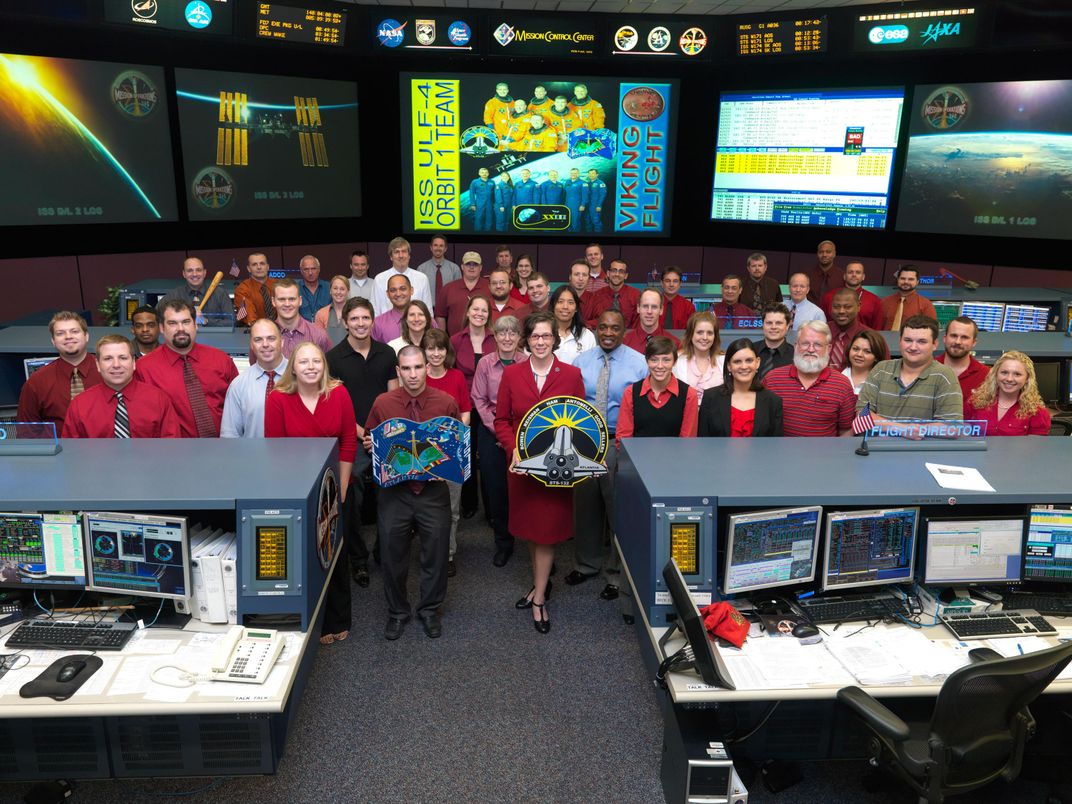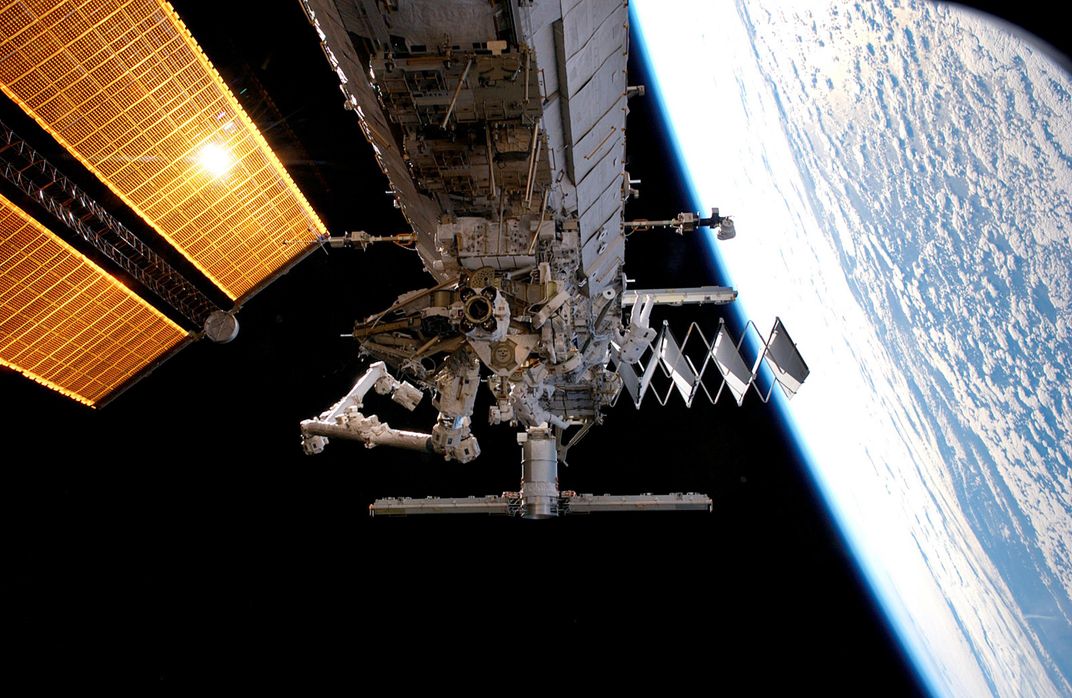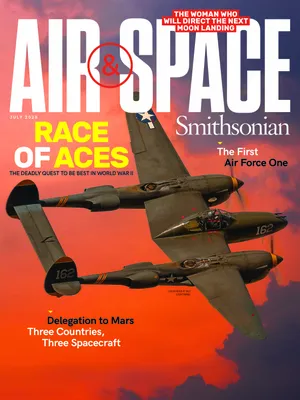Meet The Woman Who Will Direct the Next Moon Landing
As Holly Ridings takes the helm of Houston’s famed Mission Control center, another glass ceiling breaks.
:focal(1396x1083:1397x1084)/https://tf-cmsv2-smithsonianmag-media.s3.amazonaws.com/filer/0d/7c/0d7c78b3-e143-4162-8ebe-e39f8aeef9f7/10a_jj2020_20200207_nasa_ridings_0190_live.jpg)
When the space shuttle Challenger lifted off on its 10th mission, on a Tuesday morning in January 1986, Holly Ridings watched the launch on TV, along with her sixth-grade classmates, in an Amarillo, Texas middle-school cafeteria. “We watched Challenger go up into the sky,” she says, “but we didn’t understand exactly what happened, that the Y-shaped smoke trail wasn’t right. But you could tell by the tone of the teachers’ conversations and their sad faces that something went wrong.” The accident changed her life. “My reaction, as I figured it out contextually over the next few days, was, Hey, I want to help solve that problem! ”
At 12 years old, Ridings could already hear an inner engineer voice telling her that she was, in her words, “a fix-it person” and that here was something big, something important to be part of. “I’ve never met a problem that I am not going to try to solve,” she says. “Maybe that’s why I have this job. From that tragedy, my love of engineering, science, and space was born. I loved space after that.”
Ridings, who became NASA’s Chief Flight Director in September 2018, is now one of the first people NASA calls when human spaceflight problems arise. Only 12 others have held this position, and Ridings is the first woman to occupy the post. She follows in the footsteps of such legendary space men as Christopher Kraft Jr. and Apollo flight directors Gene Kranz and Gerry Griffin. And like Kraft, Kranz, and Griffin, she will soon manage the team that will send astronauts to the moon.
/https://tf-cmsv2-smithsonianmag-media.s3.amazonaws.com/filer/87/a3/87a3ac10-430c-4d78-9cff-4615b7a78da7/10b_jj2020_2_earlyholly_0097_live.jpg)
Ridings is outgoing and articulate, with an Amarillo accent and a wide Texas grin. She is model-slim, stands six-feet-tall in her two-inch heels, and, in describing the seriousness of her responsibilities, gives the impression that when the problems come, she’ll be equal to them.
She spoke about NASA’s second space shuttle disaster, in 2003, when Columbia broke into pieces as it re-entered the atmosphere. The day it happened, Ridings, who was a flight controller on the space station program at the time, was at home with her husband and fellow NASA employee, Michael Baine. NASA TV was on, as always—“because we’re space geeks,” she says. Her husband said, “Hey, there’s something going on with shuttle.” A camera in the back of the shuttle’s flight-control room broadcast the scene: “You see the ground track and you see them all standing and staring at it,” she says. “And it’s almost their body language that gets you, right? You know something is really, really wrong because we live in this world and know all those people.”
Today, she says, all controllers and flight directors, as a part of their training, are required to read the Columbia Accident Investigation Board report. She finds it hard to read. Now, with hindsight, she sees decisions that, had they gone another way, could possibly have changed the outcome. She says, “But we read that just to remind ourselves that the decisions you make every day have life or death consequences.”
/https://tf-cmsv2-smithsonianmag-media.s3.amazonaws.com/filer/1f/9d/1f9d970d-025b-42c2-96f6-c0e11ef8017f/10c_jj2020_3_dragon_iss047e050943_live.jpg)
Ridings and her deputy Emily Nelson are NASA’s first all-female Chief Flight Director team. They oversee 28 flight directors and are responsible for all human spaceflight operations: keeping the International Space Station flight crews safe and supplied; handling the Commercial Crew Program through which SpaceX and Boeing are developing new space taxis; and developing landing systems and protocols for the upcoming Artemis lunar missions, intended to once again propel humanity beyond low Earth orbit.
Former NASA Director of Flight Operations Brian Kelly, who selected Ridings, explained why he thought she was the right one to shoulder those responsibilities. “Holly balanced humility, a hunger to learn, and people skills that will make her one of the best Chief Flight Directors in NASA’s stellar history,” he wrote in an email. “She’s not just a great role model for young ladies, she is an outstanding role model for all young Americans striving to be a part of human spaceflight.”
NASA flight directors—called “Flight” by their controller teams—are responsible for the execution of a mission from start to finish. They get involved early in mission planning, and they see a mission through from training to completion. Inside mission control, as NASA’s original flight director Chris Kraft once said, “Flight is God.” The flight director collects information from all of the controllers—who in turn draw on knowledge from their backroom experts—then makes the final decisions. Nobody argues with Flight.
Before Ridings became chief, she was one of the flight directors responsible for space station missions. One of her most memorable came during Expedition 31 in October 2012, when SpaceX launched its first Dragon cargo spacecraft to the station. By then, she had been a flight director for seven years and was already used to handling “dynamic events,” situations with the highest level of risk—spacewalks and docking spacecraft, like the shuttle and Progress and Soyuz ships. But the Dragon was different. “[The capsule] had been tested, but SpaceX was new to this kind of [rendezvous-and-capture] spaceflight,” she says. “You have your space station and the crew. You’ve got this vehicle coming [at] you, and it never works perfectly.”

NASA manages space station visits through a joint operations protocol similar to that followed by a private airplane pilot who enters air-traffic-controlled airspace. During SpaceX docking missions, the company’s flight directors transmit vehicle commands and controls until the spacecraft closes with the ISS. Then the NASA flight director takes charge, reviewing and okaying the SpaceX controller’s commands.
During the Dragon’s 2012 approach to the station, Ridings says, its laser guidance equipment, which allows the vehicle to “see” where it’s going, disagreed with that aboard the ISS—a typical if unwelcome problem for a brand-new spacecraft. “Just the unknown of bringing a new vehicle in,” she says. “You have a lot of time to think, ‘What if it goes wrong?’ With vehicles that you’ve not flown before, you just don’t know what they are going to do. We ultimately decided it was safe to go ahead.”
Not everyone has what it takes to become a flight director. In NASA’s nearly 60-year history, fewer than 100 people have made it, after a year of intense training. “At first you don’t have the mental discipline,” says Ridings. “You tend to use your brain power on things that aren’t important, and you’re not willing to tell somebody, ‘No, I don’t have time to talk to you right now.’ There are so many things going on—you have to only focus on the critical parts. Otherwise, your buffers overrun and you kind of run out of space, and before you know it, you’re not making good decisions.”
For Ridings, preparation for the job started with a strong foundation in engineering. After earning a degree in mechanical engineering from Texas A&M, she got a position at NASA’s Goddard Space Flight Center in Maryland. In 1998, she moved back to Houston, where NASA’s Johnson Space Center handles all crewed spaceflight. She was assigned as a flight controller for the space station’s thermal systems. “It was fun,” she says. “I learned how we were going to operate the space station as it was being built and growing because in the beginning, there were no rules and no checklists. No one had ever done this before.”
Two years after that, Ridings was tapped to lead the ISS Attitude Determination and Control group, which oversees the station’s orientation within its orbit, making adjustments usually to accommodate visiting supply ships. “This group was guidance and navigation for the space station: yaw, pitch, and roll,” she says. It was outside the field in which she was already technically competent. “It was challenging at the time, but it taught me how to lead people when you are not the smartest person in the room, which is a very different skill from ‘I just know the thing, and I’ve been here longer, and you guys now work for me.’ ”

In 2005, Ridings ascended to flight director. In that role, NASA astronaut (and Boeing Commercial Crew member) Sunita Williams tells me Ridings has excelled in team building. “She helped integrate [SpaceX] into the NASA bureaucracy,” says Williams. “She was really a bridge there.”
Ridings started working with SpaceX in 2008, when the company was selected as one of two corporations to transport cargo to the space station. SpaceX was a brash startup, just carving out a place in spaceflight, and had its own ideas about how to proceed. NASA, on the other hand, with more than 60 years of spaceflight experience, has a tendency to think it knows best. “Just like partnering with the Russians, each of our commercial companies have their own culture and personality and priorities,” Ridings says. “And in some ways, it is actually harder because everyone speaks English so you think that English means the same to everyone. When you’re thinking Russian, you know you need to translate. When you are speaking English, sometimes you don’t know you need to translate.”
Williams also points to an experience she had with Ridings on a 2012 space station expedition. Williams and Japanese astronaut Akihiko Hoshide had problems with the station’s carbon dioxide removal system—critical to survival in space but festooned with small, sticky, counterintuitively mounted, hard-to-reach valves—and all the fixes the flight control team suggested just frustrated them. Williams finally called Ridings on a private line to ask if the astronauts could just solve the problem their own way. According to Williams, Ridings said, “Hey Suni, I’ve got a room full of experts. I can’t just override them. That’s not how I can hold this team together. But since you can see the equipment, I need you to call down and say to them, ‘This is what I see, this is what I hear.’ Then let me talk with them. Let me sway the conversation. You can’t just have me say, ‘You’re right.’ But I’m glad you phoned, because now we have an idea. Now, let me convince everybody so they’re on board and happy with the actions you perform and the decisions I make.”
Says Williams: “It was so simple. It was the way you put a team together.”
The Artemis missions—the first is scheduled for 2021, when a new rocket will fire an uncrewed Orion space capsule to lunar orbit—will bring a new set of problems to solve. Apollo flight director and former head of the Johnson Space Center Gerry Griffin told me last year, “Flight into deep space is different. It’s a very dynamic field. You’re three or three and a half days from being able to get a crew back, if you have to.” Ridings has already started to prepare. She has picked the lead flight directors for the first two missions. The simulations have begun. And shortly after she was selected as chief flight director, she had lunch with Chris Kraft. (Kraft died last July, at 95.) When she asked for his advice, he told her cryptically, “There’s more than one way to get to Spring,” a small town just north of Houston. It sounds like an oracle, but Kraft’s legacy is strong, and Ridings knows what he was saying. Kraft was flight director number one; she is number 62. “When you lead a high-performance team, you don’t over-manage,” she says. “It’s better to let them do their thing.”
That is a sound approach to a complex problem and possibly the only way we’ll ever get back to the moon.
